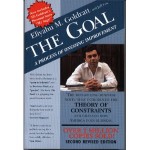Posts Tagged ‘biodiesel’
The Goal
One lesson from the book is that having excess capacity in one individual part of a plant’s process will not increase production if the step before (or after) has a lower capacity. That is, if your first machine can process 10 widgets an hour and the second machine can process 100 widgets an hour, you are still only processing 10 widgets an hour but the second machine is only working 10% of the time. The entire plant must be optimized in relation to the entire process, not the individual components. Not earth-shattering advice but it leads to the Theory of Constraints and in turn most modern operational theory such as balanced production lines, just-in-time (JIT) manufacturing, etc.
A few years ago I was raising money for a biodiesel plant. Biodiesel is made from natural fats and oils that are refined into a substitute for diesel fuel. The biggest cost for a biodiesel refinery is the feedstock (the fat or oil to be refined) which accounts for the vast majority of production costs. 80%+ of U.S. biodiesel is made from soybean oil which costs as much per gallon as diesel fuel since the price has been inflated due to biodiesel demand. After chemicals and refining costs, you are selling soy based biodiesel for less than it costs to make it (not including the sale of “RINS,” or renewable identification numbers.) The refinery is only making money 1) by selling RINS per government mandate, 2) if it is using a feedstock that is less expensive than soybean oil or 3) if the owners produce the soybean oil to sell to the refinery, in which case they don’t really need to turn a profit selling biodiesel because they are making a fortune selling soybean oil.
At the time, other competing plants announced plans to build 30+ million gallon plants across the Midwest. One notable example is Imperium Renewables which announced a 100 million gallon plant. I don’t know very much about the Imperium plant except for what is in the news but the story is as follows. Located near Seattle, Imperium intended to refine palm oil imported from Malaysia or Indonesia. Environmentalists protested the use of palm oil as the palm trees were grown on rain forest land that was deforested to make way for the palm plantations. Denied an inexpensive source of palm oil feedstock, Imperium built the plant to use soybean oil brought in by tanker truck and train from the Midwest – a negative net income proposition. The company had a few lean years with bad margins, financial troubles, and ownership turnover. The plant also, like most other refineries, operated at 30% of capacity or less due to lack of available cost effective feedstock.
The client I was raising money for realized that in order to make money selling biodiesel, he must secure inexpensive and local feedstock. We did an analysis and determined that the maximum volume we could produce locally was about 12 to 15 million gallons: we decided to build a 10 million capacity plant.
We spoke to several sources of capital to finance the business. Ultimately, the financial crisis of 2007 shut down our efforts and the plant is currently (permanently?) on hold. However, one conversation in particular stood out. The investor was an equipment leasing company owned by a large multi-national conglomerate. The lender had two curious comments. After praising the package we put together (thank you, thank you) he went on to say that a 10 million gallon plant is not optimally efficient. His claim was that 30 million gallon plants were at the “knee in the curve” as far as efficiency went. Further, he went on to say that our assumption of 90% capacity was too high as most plants in the industry were operating at 30% efficiency. My instinct was that plants in the industry were operating at 30% because they could not secure the feedstock to run at higher capacity. Further, a 30 million gallon plant may be marginally more efficient per gallon at peak capacity but at 30% efficiency they were much less efficient. Why not build a 10 million gallon plant operating at capacity than build a 30 million gallon plant running at 30% capacity (and producing the same 10 million gallons)?
The takeaway here is that the financial people do not always have a clear understanding of the issues that renewable energy companies face, even the specialists. Here the equipment leasing representative didn’t have a clue as to why the industry was running at 30%. He also clearly didn’t take the lessons from The Goal to heart. The market supply and demand are an integral part of the process. You cannot optimize of one part without taking into account the other parts. In this example, building an “optimally efficient” plant without consideration of the supply of feedstock will result in a plant running at 30% capacity which is inefficient due to so much excess capacity. For biofuels and renewable projects in general, it is paramount to keep feedstock at top of mind.
